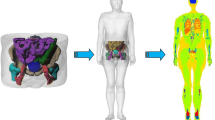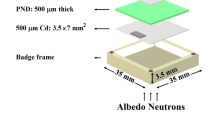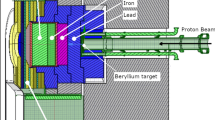Abstract
Considering the advantages of boron neutron capture therapy (BNCT) in treating prostate cancer, the amount of dose delivered to tumour and healthy tissues must be determined. Therefore, in this study, Monte Carlo analyses were performed to evaluate physical doses of adjacent healthy tissues and prostate tumours located at different depths of reference phantom developed by International Commission on Radiological Protection. According to the results, when prostate depth decreases, the amount of physical dose in tumour increases but the physical doses of healthy organs around the tumour remain constant. As expected, lithium filter decreases the damages to normal tissues. The estimations of physical dose, dose uniformity and dose distribution suggested that using BNCT with a filtered neutron beam could be applicable for prostates locate at the depths less than 7 cm from the body surface, which occurs in 5 % of all subjects.







Similar content being viewed by others
References
Ringborg U, Bergqvist D, Brorsson B, Cavallin-Sta E, Ceberg J, Einhorn N et al (2003) The Swedish Council on Technology Assessment in Health Care (SBU) Systematic overview of radiotherapy for cancer including a prospective survey of radiotherapy practice in Sweden 2001-summary and conclusions. Acta Oncol 42:357–365
Hricak H, Choyke PL, Eberhardt SC, Leibel SA, Scardino PT (2007) Imaging prostate cancer: a multidisciplinary perspective. Radiology 243:28–53
Yanagisawa K, Inoue T, Hayakawa K, Shiotari H, Nakamura Y, Matsuyama K et al (2009) Economic scale of utilization of radiation in medicine in Japan. Appl Radiat Isot 67:1387–1391
Allen BJ, Bezak E, Marcu LG (2013) Quo vadis radiotherapy? Technological advances and the rising problems in cancer management. BioMed Res Int 2013:1–9
Huang J (2009) Boron neutron capture therapy for cancer treatments. MS thesis in University of Surrey
Matsumoto T (2007) Monte Carlo simulation of depth–dose distribution in several organic models for boron neutron capture therapy. Nucl Instrum Methods A 580:552–557
Yasui L, Kroc T, Gladden S, Andorf C, Bux S, Hosmane N (2012) Boron neutron capture in prostate cancer cells. Appl Radiat Isot 70:6–12
Locher G (1936) Biological effects and therapeutic possibilities of neutrons. Am J Roentgenol 36:1–13
Farr LE, Sweet WH, Locksley HB, Robertson JS (1954) Neutron capture therapy of gliomas using boron. Trans Am Neurol Assoc 13:110
Nakagawa Y, Hatanaka H (1997) Boron neutron capture therapy: clinical brain tumor studies. J Neuro-Oncol 33:105
Barry JA (2006) Internal high linear energy transfer (LET) targeted radiotherapy for cancer. Phys Med Biol 51:327–341
Sauerwein WAG, Wittig A, Moss R, Nakagawa Y (2012) Neutron Capture Therapy. Springer, Heidelberg
Minsky DM, Kreiner AJ, Valda AA (2011) AB-BNCT beam shaping assembly based on 7Li(p, n)7Be reaction optimization. Appl Radiat Isot 69:1668–1671
Minsky DM, Kreiner AJ (2014) Beam shaping assembly optimization for 7Li(p, n)7Be accelerator based BNCT. Appl Radiat Isot 88:233–237
Barth RF (2009) Boron neutron capture therapy at the crossroads: challenges and opportunities. Appl Radiat Isot 67:3–6
Harling OK, Riley KJ (2003) Fission reactor neutron sources for neutron capture therapy-a critical review. J Neuro-Oncol 62:7–17
Barth RF, Coderre JA, Vincente MGH, Blue TE (2005) Boron neutron capture therapy of cancer: current status and future prospects. Clin Cancer Res 11:3987–4002
Mason AJ, Giusti V, Green S, Rosenschöld PM, Beynon TD, Hopewell JW (2011) Interaction between the biological effects of high- and low-LET radiation dose components in a mixed field exposure. Int J Radiat Biol 87:1162–1172
Olsson L, Arzel E, Eek A (2012) Boron compounds useful in BNCT. Available at: http://www.google.com/patents/US8183247
Zee S (1981) Physics of semiconductor devices.2nd ed. Wiley & Son, New York
International Commission on Radiological Protection (2003) ICRP Publication 89: basic anatomical and physiological data for use in radiological protection: reference values. Pergamon press, Oxford
International Commission on Radiological Protection (2008) ICRP Publication 110: adult reference computational phantoms. Elsevier, Amsterdam
Attix FH (1986) Introduction to radiological physics and radiation dosimetry. Wiley & Son, New York
Auterinena I, Sere´n T, Anttilaa K, Kosunen A, Savolainen S (2004) Measurement of free beam neutron spectra at eight BNCT facilities worldwide. Appl Radiat Isot 61:1021–1026
Binns PJ, Riley KJ, Ostrovskyy Gao W, Aabritton JR, Kiger WS et al (2007) Improved dose targeting for a clinical epithermal neutron capture beam using optical 6Li filtration. Int J Radiat Oncol Biol Phys 67:1484–1491
Gao W (2005) Lithium-6 filter for a fission converter-based boron neutron capture therapy irradiation facility beam. MSc thesis at Massachusetts Institute of Technology
Wagner FM, Loeper-Kabasakal B, Breitkreutz H (2011) Neutron medical treatment of tumors- a survey of facilities. Second international workshop on fast neutron detectors and applications, EinGedi
Joensuu H, Kankaanranta L, Auterinen I, Kallio M, Kulvik M, Laakso J (2003) Boron neutron capture therapy of brain tumors: clinical trials at the Finnish facility using boronophenylalanine. J Neuro-Oncol 62:123–134
Viaggi M, Dagrosa MA, Longhino J, Blaumann H, Calzetta O, Kahl SB et al (2004) Boron neutron capture therapy for undifferentiated thyroid carcinoma: preliminary results with the combined use of BPA and BOPP. Appl Radiat Isot 61:905–909
Blue TE, Yanch JC (2003) Accelerator-based epithermal neutron sources for boron neutron capture therapy of brain tumors. J Neuro-Oncol 62:19–31
Nievaart VA, Moss RL, Kloosterman JL, van der Hagen THJJ, van Dam H (2007) Spectral tailoring for boron neutron capture therapy. IOS Press, Amsterdam
Drzymala RE, Mohan R, Brewster L, Chu J, Goitein M, Harms W et al (1991) Dose-volume histograms. Int J Radiat Oncol 21:71–78
Conflict of interest
We certify that there is no conflict of interest with any financial organization regarding the material discussed in the manuscript.
Author information
Authors and Affiliations
Corresponding author
Rights and permissions
About this article
Cite this article
Mirzaei, D., Miri-Hakimabad, H. & Rafat-Motavalli, L. Depth dose evaluation for prostate cancer treatment using boron neutron capture therapy. J Radioanal Nucl Chem 302, 1095–1101 (2014). https://doi.org/10.1007/s10967-014-3397-2
Received:
Published:
Issue Date:
DOI: https://doi.org/10.1007/s10967-014-3397-2




